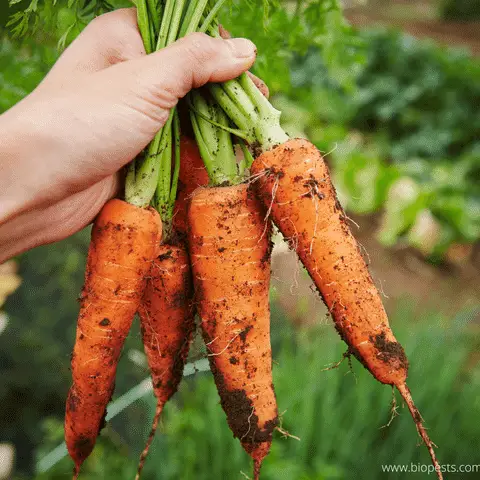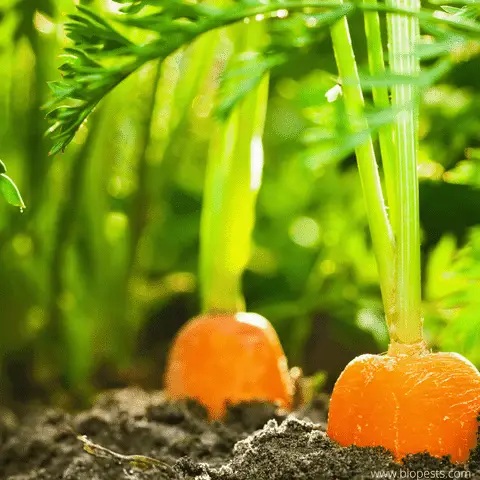Carrots are one of the first root crops that many new gardeners start with since they are easy to grow. If you notice your carrot tops beginning to wilt, it may indicate that you are not caring for your carrot correctly or that something more sinister is at the root of the problem.
Carrot tops can wilt from overwatering or underwatering, which is easy to fix. Other more difficult to identify causes for carrot top wilt include bacterial and fungal infections. Pests that damage the carrot root can also result in carrot top wilting and should be investigated to limit crop loss.
Carrots can be fairly easy to grow, but they have some specific requirements for soil types and care, but these are not difficult to maintain. If your carrot tops are wilting, we have some suggestions of the potential cause and what you can do to address the problem.
What Causes Carrot Tops To Wilt?
Carrots are a delicious and nutritious root vegetable that can be grown in a variety of climates. They are also easy to grow in many different environments, including directly in the soil, containers, pots, or raised beds.
Wilting of the carrot tops is a common problem that can have a number of different causes, which may not be immediately obvious to new gardeners.
Before you become frustrated with growing carrots and change to a different crop, it is worth investigating the following causes of wilting.
You may be able to remedy the wilting problem and adjust your growing methods or take steps to remove the cause of the problem.
Planting in The Wrong Season Can Cause Carrots Tops To Wilt
Carrots are a cool-season crop and do not do well in extreme heat. Planting carrots at the wrong time of year can cause the tops to wilt when the temperature becomes too hot.
Even if you plant in the right season, a sudden hot spell can cause the carrot tops to wilt. Providing some shade over the carrots, such as a 30% shade cloth, will help reduce the temperature for the carrots to bounce back.
Carrots grow best in temperatures between 40°F and 80°F or 4°C to 26.6°C. If you have summer temperatures that get above this range, your carrot tops can wilt in the heat.
The best season to grow carrots is in the fall to reap an early winter harvest. The temperatures in the fall are generally within the tolerance levels of the carrots.

Underwatering Can Cause Carrot Tops To Wilt
If you’re noticing that the tops of your carrots are wilting, one likely problem is due to underwatering. When the soil is too dry, it can cause the plant to wilt in an effort to conserve water.
Fortunately, this problem is easily investigated and solved. Stick your index finger into the top of the soil up to the second knuckle, about an inch to 1.5-inches deep or 2.5cm to 3.8cm. If the soil feels dry to this depth, your carrots must be watered.
Give the carrots a deep watering, and they should bounce back in a short time. Make sure your carrots do not get this dry again, as lack of water will affect the soil and availability of nutrients and stress the plant, so it does not grow big roots.
Overwatering can cause Carrot Tops To Wilt
Overwatering carrots can be even more damaging than underwatering. Overwatering will cause the soil to be soggy around the carrot root, promote fungal infections, and potentially cause root rot.
The same finger test used for underwatering can be used to test for overwatering. If the soil feels moist and cool at 1 to 1.5 inches or 2.5cm to 3.8cm deep, the moisture you have the balance right. If the soil feels wet, you are watering too much.
Carrots prefer deep periodic watering rather than daily watering. A deep watering once a week in cooler weather or once every 3 days in warmer weather will keep your carrots happy and prevent wilting.
Planting carrots in an incorrect soil type can cause problems similar to overwatering if the soil contains too much clay and retains too much moisture. Well-draining, loose soil rich in organic matter is best for growing carrots.
Fungal Infections Can Cause Carrot Top Wilting
Several fungi can attack carrots which can have leaf wilting as a symptom, but the most common fungal infection in carrots is from Pythium fungi.
This infection in carrots is commonly called cavity spot and Pythium root dieback and is a predominant problem for carrots in wet soil. This fungal infection causes damage to the carrot root, which can cause leaf wilt as one of the above-ground symptoms.
Other fungal infections that can result in leaf wilt are Sclerotinia Rot or white mold. This fungus may be present on one or two carrots in the ground and display as leaf wilt. When the carrots are harvested and kept together, the fungus quickly spreads to all the carrots in the container.
Cercospora Leaf spot is another fungal-type infection that develops on the carrot leaves themselves and will cause them to wilt. Rust-colored oval lesions will also be visible on the leaf stems.
Most fungal problems for carrots can be prevented by not overwatering and practicing crop rotation. Overwatering provides wet conditions conducive to fungal proliferation and increases the risk of infection.
Crop rotation, which means not growing carrots in the same location every year, will help to reduce the incidence of fungal infections in the carrots.
Another great way of prevention is to mix your soil with worm humus (vermicompost). You can read this article to learn how earthworms can help us to prevent fungal attacks.
Bacterial Infections Can Cause Carrot Tops To Wilt
One of the main bacterial infections on carrots that cause damage to the leaves and can result in leaf wilt is bacterial leaf spot.
This bacterial disease is caused by the Pseudomonas and Xanthomonas bacteria and proliferates in the warmer parts of the season at temperatures between 77°F and 86°F or between 25°c and 30°C.
The bacteria prefer these warm conditions combined with moist conditions to multiply. They are generally transmitted to the plant by water splash when water drops hit the bacteria-infested soil and splash onto the leaves, transferring the bacteria to the leaves with the water.
Initial signs of the infection are yellow spots that turn brown, with the outer edge of the spot called the halo remaining yellow. The infection can also present as light and dark shades on the leaves.
The best prevention method for bacterial infection in carrots is to remove infected leaves as soon as you notice them and avoid overhead watering of your carrots, preventing water splashes from spreading the bacteria.
Root Damage Can Cause Carrot Tops To Wilt
The main part of the carrot grows underground in the form of the large root that develops, which is the part that we eat.
Any damage to the root, whether the cause is a pest, a disease, or damaging the root with a garden tool, can cause wilting of the carrot tops.
The root stores nutrients and water to keep the plant growing well, and any damage to the root will hinder the plant.s growth and health.
For this reason, we plant carrots where they will grow for the season rather than starting them out in seed trays and planting them out in a garden bed when they are bigger.
Carrots do not transplant well due to the damage caused to the roots when they are dug up and relocated. To prevent this root damage from causing the carrot tops to wilt in seedlings, do not transplant carrots. Start them in the location where they will grow all season.
Carrot Pests Can Cause Carrot Tops To Wilt
There are a number of carrot pests that attack the carrot root, which can display as leaf wilting. The Carrot fly is one of the most common carrot pests that can damage carrots in this way.
Our article “Why DoMy Carrots Have Holes?” details problems caused by this carrot crop pest and the steps you can take to avoid infestation and damage from these insects.
The carrot fly lays its eggs on the soil around the carrots, and when the larvae hatch, they burrow into the soil and into the carrot root. The root damage often presents the above-ground symptom of leaf wilt.
The best prevention methods against carrot fly infestation are physical protection of the crop by using barriers the flies cannot penetrate and practicing crop rotation to break the carrot fly life cycle.
Carrot weevil is another carrot crop pest that can result in leaf wilt as a symptom. The carrot weevil in a beetle is a common problem for carrot crops. The female beetle lays eggs in a cavity that she chews into the leaf petiole or an exposed part of the root crown and then covers the egg cavity with a dark anal secretion.
When the eggs hatch, they tunnel into the carrot root, damaging the root, which is noticeable by the leaves beginning to wilt.
The main prevention measures for carrot weevils are physical traps to catch adult beetles or intervention with insecticide.
Conclusion
The most likely cause for carrot tops wilting is under or overwatering, but if you are certain you have planted in the right soil type, and your watering schedule is correct, there may be other causes for carrot top wilt.
Fungal, bacterial, and pest infestations are the next causes to investigate, and it will take some research to identify the best remedial steps to take to protect your carrot crop.
Some of the links above are affiliate links, meaning, at no additional cost to you, I will earn a commission if you click through and make a purchase.

